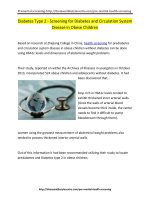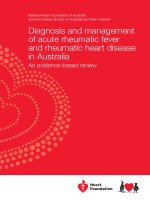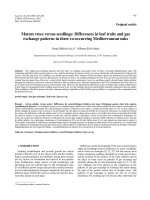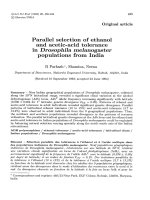Varietal reactions of turmeric towards leaf spot and rhizome rot disease in Konkan Region of Maharashtra, India
Bạn đang xem bản rút gọn của tài liệu. Xem và tải ngay bản đầy đủ của tài liệu tại đây (141.37 KB, 7 trang )
Int.J.Curr.Microbiol.App.Sci (2019) 8(10): 1735-1741
International Journal of Current Microbiology and Applied Sciences
ISSN: 2319-7706 Volume 8 Number 10 (2019)
Journal homepage:
Original Research Article
/>
Varietal Reactions of Turmeric towards Leaf Spot
and Rhizome Rot Disease in Konkan Region of Maharashtra, India
R. R. Rathod1*, A. P. Suryawanshi2, R. G. Khandekar3,
U. B. Pethe4 and C. B. Gondhalekar1
1
2
Department of Plant Pathology, College of Agriculture, Dapoli, India
Department of Plant Pathology, 3Department of Horticulture, 4Department of Agriculture
Botany, Dr. B. S. Konkan Krishi Vidyapeeth, Dapoli, India
*Corresponding author
ABSTRACT
Keywords
Curcuma longa,
Screening,
Susceptible,
Resistant,
Moderately
Resistant
Article Info
Accepted:
12 September 2019
Available Online:
10 October 2019
Turmeric (Curcuma longa L.) is well known for its medicinal value, its cultivation is
hindered by several diseases viz., leaf spot, anthracnose and rhizome rot. These diseases
are managed by using the fungicides, which leads to development of resistant strains
besides the environmental pollution and also the residue problem on final produce. Host
resistance seems to be most promising means of disease management. Therefore, field
screening trial was planned and conductd in Konkan region of Maharashtra at Asond
Block, AICRP on Spices, DBSKKV, Dapoli for three years (2015-16, 2016-17 & 2017-18)
to identify the disease resistant sources against Colletotrichum leaf spot and Pythium
rhizome rot with high yield potential. Three years average data revealed that, out of 30
turmeric varieties screened, 29 were found moderately resistant (MR) and only one variety
Kanti was susceptible (S) to Colletotrichum leaf spot. But, on the yield basis amongst all
varieties, four varieties viz., Krishna, Sudharsana, Narendra Haldi and Pratibha performed
well. Minimum leaf spot intensity was recorded in Pratibha (11.69%), Sudharsana
(12.99%), Krishna (13.23%) and NarendraHaldi (13.82%) with high yield of 17.66kg/plot,
18.86kg/plot, 19.46kg/plot and 18.10kg/plot, respectively. Whereas, for rhizome rot, the
varieties Pratibha,Sudharsana and NarendraHaldi were tolerant (T) and only one variety
Krishna was found moderately resistant (MR). It is concluded from present study that,
Krishna, Sudharsana, Narendra Haldi and Pratibha, which may be recommended to
farmers for cultivation in Konkan region of Maharashtra.
Introduction
Haldi or turmeric (Curcum alonga L.) is one
of the most important condiment and
colouring agents of the world. Turmeric is also
a commodity of auspicious religious
ceremonies in India. It is being used
essentially in curry powder and is a common
food preservative. Turmeric is grown in the
states of Tamil Nadu, Kerala, Assam, Andhra
1735
Int.J.Curr.Microbiol.App.Sci (2019) 8(10): 1735-1741
Pradesh, West Bengal and Maharashtra.
Turmeric belongs to family Zingiberaceae.
It is originated from Tropical South Asia. It is
named as “Indian saffron”. Its active
ingredient is curcumin. Indian turmeric is
considered the best in the world due to
presence of high curcumin content. Turmeric
contains essential oils up to 5% and curcumin
up to 5%, a polyphenol (Anonymous 2012).
and Pythium rhizome rot. Use of resistant
varieties is the most economic and easily
adoptable method in integrated disease
management. Identification of high yielding
turmeric varieties which are relatively
resistant or tolerant to major diseases are of
utmost importance for increasing the
production and productivity of turmeric in
konkan region of Maharashtra.
Materials and Methods
Though it is well known for its medicinal
value, its cultivation is hindered by several
diseases. Turmeric is susceptible to diseases
viz., leaf spot, anthracnose and rhizome rot.
Leaf spot caused by Colletotrichum capsici,
was found increasing and occurring regularly
every year. It has become as major constraint
in successful cultivation of turmeric.
The disease resulted in drastic reduction in
rhizome yield. Rhizome rot caused by
Pythium sp. is a major constraint in all
turmeric-growing areas of India (Rathiah,
1987; Nageshwar Rao, 1994; Ramarethinam
and Rajagopal, 1999).
Different species of Pythium is involved in
causing rhizome rot in different parts of the
country. Rhizomerot of turmeric incited by
Pythium aphanidermatum was first reported in
Sri Lanka by Park (1934), later it was reported
as P. graminicoloumfrom the Krishna district
of Andhra Pradesh by Ramakrishnan and
Sowmini (1954) and P. myriotylum from
Assam by Rathiah (1982).
Thirty different varieties of turmeric viz., 1)
Krishna, 2) Rajpuri, 3) Salem local, 4) Ranga,
5) Pratibha, 6) Roma, 7) Pant Peethabh, 8)
Narendra Haldi, 9) Sona, 10) BSR-1, 11)
BSR-2, 12) Kedaram, 13) Panjab Haldi-1, 14)
Panjab Haldi-2, 15) Sobha, 16) Prabha, 17)
Suvarna, 18) Suguna, 19) Sudharshna, 20)
Kanti, 21) Sikandarabad, 22) Alleppy
Supreme, 23) SB – 10843, 24) RH – 5, 25)
Arunachal Local,
26)
Cochbet,
27)
Tekurpeta, 28) Jalpalguri local, 29) Allam
puram and 30) Suranjana, were planted at 37.5
X 30cm spacing at Asond Farm, AICRP on
Spices, Dapoli (Dr. B. S. Konkan Krishi
Vodyapeeth, Dapoli) during the period of
2015 -16 to 2017-18.
Observations were recorded on Per cent
Disease Intensity (1-5 point scale), Per cent
Disease Incidence (1-6 point scale). Disease
score chart for leaf spot disease and rhizome
rot disease are as follows –
At present the disease was managed by using
the fungicides which lead to development of
resistant strains besides the environmental
pollution and also the residue problem on final
produce. Hence, field screening trial was
conducted during three years (2015-16, 201617 & 2017-18) to identify the disease resistant
varieties in the available thirty different
varieties against the Colletotrichum leaf spot
1736
Disease Score Chart (leaf spot disease)
Grade
1
2
3
Incidence
(%)
Upto 5%
5 – 10%
11 – 25%
4
5
26 – 50%
> 50%
Category
Highly Resistant
Resistant
Moderately
Resistant
Susceptible
Highly Susceptible
Int.J.Curr.Microbiol.App.Sci (2019) 8(10): 1735-1741
Disease Score Chart (Rhizome rot disease)
Grade
1
2
Incidence (%)
0.0
1.0 – 5.0
3
4
6.0 – 15.0
16.0 – 25. 0
5
6
26.0 – 40.0
Above 40.0
Colletotrichum leaf spot are given in Table 1.
The results revealed that, out of thirty varieties
of turmeric screened, twenty nine varieties
were observed moderately resistant.
Category
Resistant
Moderately
Resistant
Tolerant
Moderately
Tolerant
Susceptible
Highly
Susceptible
The severity of the leaf spot showed variation
among the turmeric verities screened in the
range of 11.69 to 24.86 PDI. The interest point
observed on foliar diseases in the present
study is that, no other leaf spot/ blight/ blotch
diseases were observed on these varieties.
Results and Discussion
The
response
of
the
verities
against
In present study, only one variety, Kanti was
found susceptible (30.74 PDI) against leaf
spot disease of turmeric.
Table.1 Reactions of turmeric against Colletotrichum leaf spot disease of turmeric
Sr.
No
Variety
Reactions
Sr.
No
Variety
Krishna
Rajpuri
Per cent
Disease
Intensity
13.23
16.21
1.
2.
3.
4.
5.
6.
7.
8.
9.
10.
11.
12.
13.
14.
15.
MR
MR
16.
17.
Salem Local
Ranga
Pratibha
Roma
Pant Peetabh
NarendraHaldi
Sona
BSR-1
BSR-2
Kedaram
Punjab Haldi-1
Punjab Haldi-2
Sobha
21.12
20.59
11.69
20.07
16.10
13.82
12.24
15.13
22.80
16.72
16.30
15.99
15.90
MR
MR
MR
MR
MR
MR
MR
MR
MR
MR
MR
MR
MR
18.
19.
20.
21.
22.
23.
24.
25.
26.
27.
28.
29.
30.
1737
Reactions
Prabha
Suvarna
Per cent
Disease
Intensity
19.53
13.09
Suguna
Sudarsana
Kanti
Sikandarabad
Alleppeysupreme
SB-10843
RH-5
Arunachal Local
Cochbet
Tekurpeta
Jalpalguri Local
Allampuram
Suranjana
13.01
12.99
30.74
21.51
24.86
18.49
18.32
22.38
16.49
19.61
19.34
18.69
19.46
MR
MR
S
MR
MR
MR
MR
MR
MR
MR
MR
MR
MR
MR
MR
Int.J.Curr.Microbiol.App.Sci (2019) 8(10): 1735-1741
Table.2 Reactions of turmeric against Pythium rhizome rot of turmeric
Sr.
No.
Variety
Reactions
Sr.
No.
Variety
Krishna
Per cent
Disease
Incidence
4.92
1.
2.
3.
4.
5.
6.
7.
8.
9.
10.
11.
12.
13.
14.
15.
Reactions
Prabha
Per cent
Disease
Incidence
8.86
MR
16.
Rajpuri
Salem Local
Ranga
Pratibha
Roma
Pant Peetabh
NarendraHaldi
Sona
BSR-1
BSR-2
Kedaram
Punjab Haldi-1
Punjab Haldi-2
Sobha
11.55
12.98
11.62
11.07
12.08
10.05
8.19
9.89
8.61
9.73
8.83
9.55
9.84
11.61
T
T
T
T
T
T
T
T
T
T
T
T
T
T
17.
18.
19.
20.
21.
22.
23.
24.
25.
26.
27.
28.
29.
30.
Suvarna
Suguna
Sudarsana
Kanti
Sikandarabad
Alleppey supreme
SB-10843
RH-5
Arunachal Local
Cochbet
Tekurpeta
Jalpalguri Local
Allampuram
Suranjana
7.58
7.25
9.58
5.40
7.80
9.99
10.79
8.28
8.70
10.68
9.82
10.68
8.86
7.58
T
T
T
T
T
T
T
T
T
T
T
T
T
T
T
Table.3 Average yield performance of turmeric varieties
Sr.
No.
1.
2.
3.
4.
5.
6.
7.
8.
9.
10.
11.
12.
13.
14.
15.
Variety
Krishna
Rajpuri
Salem Local
Ranga
Pratibha
Roma
Pant Peetabh
NarendraHaldi
Sona
BSR-1
BSR-2
Kedaram
Punjab Haldi-1
Punjab Haldi-2
Sobha
Average Yield
kg/ plot
t/ha
19.46
31.14
12.24
19.58
11.70
18.72
12.77
20.44
17.66
28.26
13.27
21.24
12.38
19.82
18.10
28.97
13.47
21.56
11.97
19.15
13.06
20.90
13.64
21.83
12.70
20.33
11.74
18.78
11.80
18.88
Sr.
No.
16.
17.
18.
19.
20.
21.
22.
23.
24.
25.
26.
27.
28.
29.
30.
1738
Variety
Prabha
Suvarna
Suguna
Sudarsana
Kanti
Sikandarabad
Alleppeysupreme
SB-10843
RH-5
Arunachal Local
Cochbet
Tekurpeta
Jalpalguri Local
Allampuram
Suranjana
Average Yield
kg/ plot
t/ha
13.36
21.37
12.77
20.44
12.86
20.58
18.86
30.18
11.20
17.93
11.88
19.01
15.23
24.37
10.60
16.96
12.86
20.58
10.40
16.65
10.37
16.60
10.78
17.24
9.67
15.46
14.58
23.33
12.20
19.53
Int.J.Curr.Microbiol.App.Sci (2019) 8(10): 1735-1741
Table.4 Economics of turmeric
Sr.
No.
1
1
2
3
4
5
6
7
8
9
10
11
12
13
14
15
16
17
18
19
20
21
22
23
24
25
26
27
28
29
30
Treatment
Per cent
Disease
Incidence
(PDI)
Yield (t/ha)
Gross value
of yield
(Rs./ha)
Total
cost
(Rs./ha)
Cost:
Benefit
ratio
7
473042
473042
473042
473042
473042
473042
473042
473042
473042
473042
473042
473042
473042
473042
473042
473042
473042
473042
473042
473042
473042
473042
473042
473042
473042
473042
473042
473042
473042
473042
8
1 : 2.63
1 : 1.66
1 : 1.58
1 : 1.73
1 : 2.39
1 : 1.80
1 : 1.68
1 : 2.45
1 : 1.82
1 : 1.62
1 : 1.77
1 : 1.85
1 : 1.72
1 : 1.59
1 : 1.60
1 : 1.81
1 : 1.73
1 : 1.74
1 : 2.55
1 : 1.52
1 : 1.61
1 : 2.06
1 : 1.43
1 : 1.74
1 : 1.41
1 : 1.40
1 : 1.46
1 : 1.31
1 : 1.97
1 : 1.65
2
3
4
6
Krishna
Rajpuri
Salem Local
Ranga
Pratibha
Roma
Pant Peetabh
NarendraHaldi
Sona
BSR-1
BSR-2
Kedaram
Punjab Haldi-1
Punjab Haldi-2
Sobha
Prabha
Suvarna
Saguna
Sudarsana
Kanti
Sikandarabad
Alleppey Supreme
SB-10843
RH-5
Arunachal Local
Cochbet
Tekurpeta
Jalpalguri Local
Allampuram
Suranjana
13.23
16.21
21.12
20.59
11.69
20.07
16.10
13.82
12.24
15.13
22.80
16.72
16.30
15.99
15.90
19.53
13.09
13.01
12.99
30.74
21.51
24.86
18.49
18.32
22.38
16.49
19.61
19.34
18.69
19.46
31.14
19.58
18.72
20.44
28.26
21.24
19.82
28.97
21.56
19.15
20.90
21.83
20.33
18.78
18.88
21.37
20.44
20.58
30.18
17.93
19.01
24.37
16.96
20.58
16.65
16.60
17.24
15.46
23.33
19.53
1245733.33
783200.00
748666.67
817600.00
1130266.67
849466.67
792666.67
1158666.67
862266.67
766133.33
835866.67
873066.67
813066.67
751066.67
755200.00
854933.33
817466.67
823066.67
1207066.67
717066.67
760266.67
974666.67
678400.00
823200.00
665866.67
664133.33
689733.33
618533.33
933200.00
781066.67
1739
Int.J.Curr.Microbiol.App.Sci (2019) 8(10): 1735-1741
This study is in accordance with the finding of
Mallikarjun (1996), Phlip, J. and Nair, P.C.
(1981), Gorawar et al., (2006), Singh (2007)
and Jagtap et al., (2013).
In turmeric, rhizome rot is another destructive
disease that also causes economic damage to
the crop. A total of 30 varieties were screened
against Pythium rhizome rot of turmeric, out
of which, only one, Krishna variety was found
moderately resistant (4.92 PDI) and rest all
twenty nine varieties were tolerant (Table 2).
On the yield basis all varieties performed well
but on basis of per cent disease intensity
incidence of yield the varieties viz., Krishna
(31.14 t/ha), Sudharsana (30.18 t/ha),
Narendra Haldi (28.97 t/ha) and Pratibha
(28.26 t/ha) were found superior over other
varieties under study (Table 3).
Table 4, revealed that, highest C:B ratio was
recorded in Krishna, Sudharsana, Narendra
Haldi and Pratibhaas 1: 2.63, 1: 2.55, 1: 2.45
and 1: 2.39 respectively.
On the yield basis all varieties performed well
but on basis of percent disease intensity
incidence and yield of the varieties viz.,
Krishna, Sudharsana, Narendra Haldi and
Pratibha were found superior over other
varieties under study, which may be
recommended to farmers for cultivation in
konkan region of Maharashtra.
Out of thirty varieties screened, it is
recommended that four varieties viz., Krishna,
Sudharsana, Narendra Haldi and Pratibhaare
moderately resistant to Colletotrichum leaf
spot and Pythium rhizome rot with good yield.
Acknowledgement
Dr. R. R. Rathod, is grateful to the Ex-Head,
Dept. of Pl Pathology (Dr. V.S. Pande), Head,
Department of Horticulture (Dr. B. R. Salvi)
for the help provided. He wish to express
sincere gratitude),The Associate Dean, COA,
Dapoli (Dr. U.V. Mahadkar) for their
guidance. The support rendered by the
Director of Research, DBSKKV, Dapoli (Dr.
P.M. Haldankar), the Dean, DBSKKV, Dapoli
(Dr. S.S. Narkhede), The Director of
Extension Education, DBSKKV, Dapoli (Dr.
S. G. Bhave) and the Director, IISR,
Kozhikode (Dr. K. NirmalBabu) are sincerely
acknowledged.
References
Gorawar Mamatha M., Hegde, Y. R. and
Kulkarni S. 2006. Screening of
genotypes and effect of fungicides
against leaf blight of turmeric.
Jagtap, G. P., Mali, A. K. and Utpal Dey 2013.
Bioeficacy of fungicides, bio-control
agents and botanicals against leaf spot
of turmeric incited by Colletotrichum
capsici.African
Journal
of
Microbiology Research. Vol. No. 7
(18): pp 1865-1873.
Mallikarjun, G. 1996. Studies on Alternaria
alternata, M.Sc. (Agri) Thesis,
University of Agricultural Sciences,
Dharwad. pp-48
NageshwarRao T.G. 1994. Turmeric rhizome
rot and its management. Spice India.7:
17-19.
Narsimha Rao, S.. Ravindra Kumar, K. and
Prameela, M. 2015. In vivo screening
of Turmeric (Curcuma longa L.)
germplasm of different duration groups
against Leaf spot caused by
Colletotrichum capsici ((Sydner) Butl
& Bis).
Ramakrishanan, T.S. and Sowmini, C. K.
1954. Rhizome root rot of turmeric
caused by P. graminicolum. Ind.
Phytopath. 7: 152-159.
Ramana K.V. and Eapen, S. J. 1995. Parasitic
nematodes and their management in
major spices. J. of Spices and Aromatic
Crops.4(1): 1-16
1740
Int.J.Curr.Microbiol.App.Sci (2019) 8(10): 1735-1741
Ramarethianum, C. and Rajagopal B. 1999.
Efficacy of Trichoderma spp. organic
amendments and seed dressing
fungicides on rhizome rot of turmeric.
Pestology. 13: 21-30.
Rathaiah Y. 1982. Rhizome rot of turmeric.
Indian Phytopath.35: 415 -417.
Rethiah Y. 1987. Control of soft rot of ginger
with Ridomil. Pesticides. 21: 29-30.
Singh, A. K. 2007. Screening of turmeric
cultivars against Taphrina and
Colletotrichum leaf spot diseases. Ind.
J. of Pl. Prot. 35 (1): 142-143.
How to cite this article:
Rathod, R. R., A. P. Suryawanshi, R. G. Khandekar, U. B. Pethe and Gondhalekar, C. B. 2019.
Varietal Reactions of Turmeric towards Leaf Spot and Rhizome Rot Disease in Konkan Region
of Maharashtra, India. Int.J.Curr.Microbiol.App.Sci. 8(10): 1735-1741.
doi: />
1741









